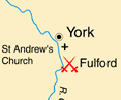![]() Harold
of England and Harald of Norway
Harold
of England and Harald of Norway
 In 1066 Harald Hardrada, King of
Norway, claimed the English throne. After serving as a Viking mercenary in the
service of the Byzantine Emperors, Harald had ruled Norway for twenty years
and become one of the most feared rulers of northern Europe.
In 1066 Harald Hardrada, King of
Norway, claimed the English throne. After serving as a Viking mercenary in the
service of the Byzantine Emperors, Harald had ruled Norway for twenty years
and become one of the most feared rulers of northern Europe.
On his journey to England Harald gathered warriors in Shetland and the Orkney islands before meeting his ally Tostig, King Harold’s vengeful brother, recently deposed as Earl of Northumberland, at the mouth of the River Tyne. The Norsemen then sailed up the Humber in 300 ships and landed at Riccall, 10km south of York.
![Church of St Andrew's, Fishergate, York, walls visible as trenches only, with medieval graves [York Archaeological Trust]](images/graves.jpg)
![Skeleton of a man who may have died in the battle of Fulford in 1066 [York Archaeological Trust]](images/skel1.jpg) Harald
defeated an English army at Fulford just south of York, then the largest and
most important town in northern England, on 20th September, and entered the
city itself. Excavations at a church site in York found skeletons of men
thought to have died in the battle.
Harald
defeated an English army at Fulford just south of York, then the largest and
most important town in northern England, on 20th September, and entered the
city itself. Excavations at a church site in York found skeletons of men
thought to have died in the battle.
 After the battle of Fulford, Harald
moved his army 12km east of York to Stamford Bridge on the River Derwent.
Meanwhile, King Harold of England marched his army northward and on the 25th
September defeated Harald Hardrada at the battle of Stamford Bridge. There was
great slaughter with Harald and Tostig both killed. It is said that only 24
ships were needed to take the Norse army home.
After the battle of Fulford, Harald
moved his army 12km east of York to Stamford Bridge on the River Derwent.
Meanwhile, King Harold of England marched his army northward and on the 25th
September defeated Harald Hardrada at the battle of Stamford Bridge. There was
great slaughter with Harald and Tostig both killed. It is said that only 24
ships were needed to take the Norse army home.
On 27th September, two days after Harold’s victory, Duke William of Normandy landed his army at Pevensey in Sussex.